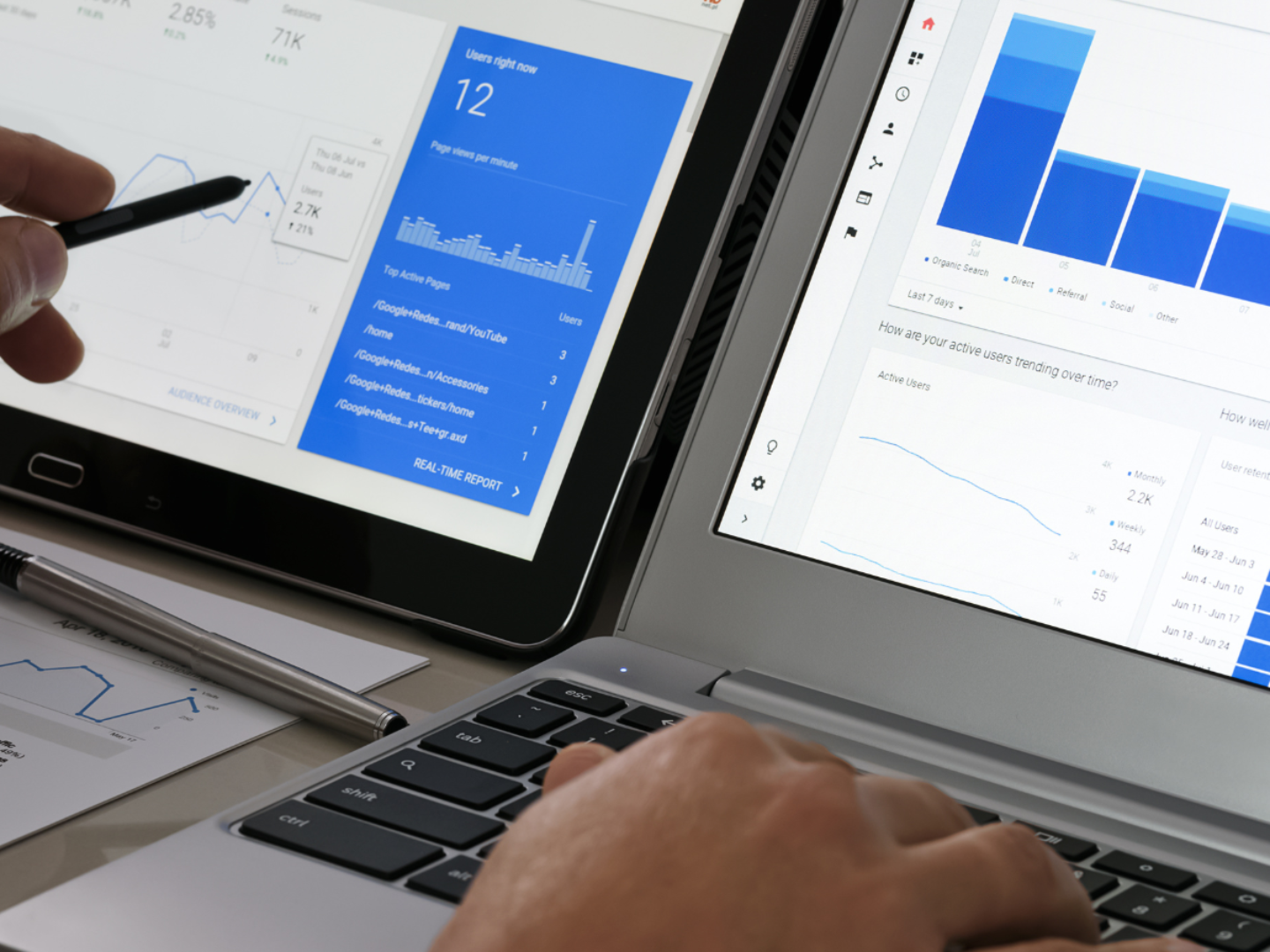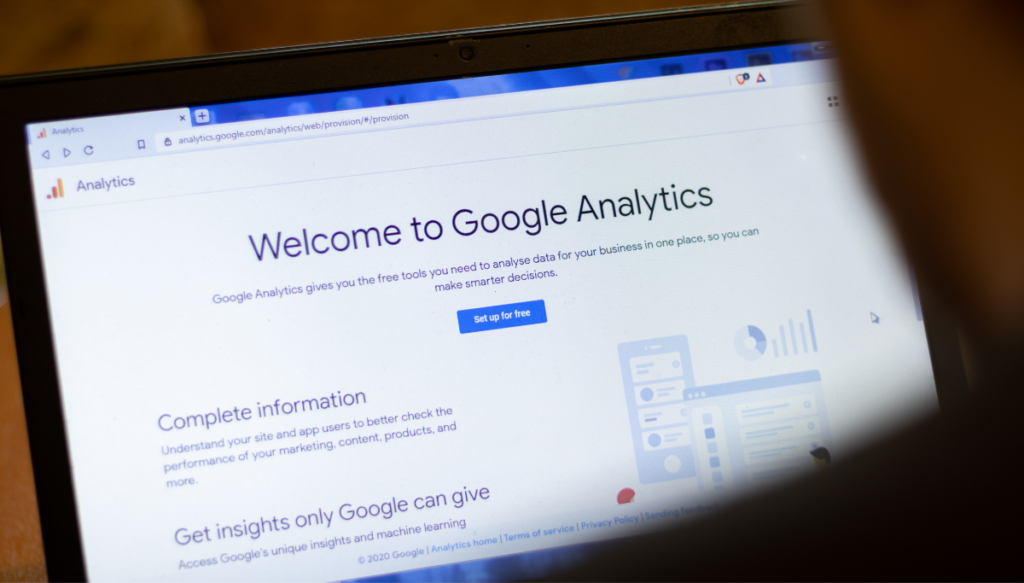What to expect with Google Analytics 4.

In March 2022, Google confirmed it’s sunsetting Universal Analytics (UA) next year, on July 1st 2023. As such, all accounts using UA will need to start using Google Analytics 4 (GA4) to continue gathering data.
While GA4 remains free for users, similar to UA, there are a lot of differences between the two analytics in more than just appearance. Because of this, we wanted to break down what some of those are.
Google Analytics 4 is Google’s latest analytics tool. Google Analytics has been used by millions of businesses, and marketers, with its aim to report on user engagement and interactions.
This focus remains the same, but GA4 differs in reporting this within analytics. With a new data model tool and AI, it allows GA4 to consolidate desktop and mobile app traffic usage, to help better track user interactions in one property, in one interface.
Google is suspending Universal Analytics on July 1 2023. From then, there will be no data recorded on UA, only on GA4. You’ll then have access to your historical data on UA for six months before all UA data will be permanently deleted.
There are workarounds for exporting data, with Google expected to announce more on this later and a confirmed date for when UA properties will no longer be available.
One of the critical differences between Universal Analytics and Google Analytics 4 is the data collection and measurement. Below, we’ve broken down what these differences are:
One of the most significant changes for GA4 is how the data is presented. With UA having data split off into various tabs, GA4 has merged all into one overview section using widgets. Previously, this is where ‘Audience, Acquisition, Behaviour and Conversions’ menus were, now replaced with a Life Cycle section, which divides analysis. As with the widgets, you can click into these menu items for more information, but you get a cleaner, more insightful first layer when you log in.
UA’s “Goals” have been removed in GA4 and replaced with “Conversions”. All actions taken on a site using GA4 are tracked as events. “Conversions” are triggered when an event matches the given criteria (similar to how Goals worked). This allows more flexibility to set granular conversions.

Previously, UA’s data measurement has been on a model based on sessions and page views, with a session being a group of user interactions or hits. As such, UA grouped interactions under individual sessions and placed an emphasis on the behaviour within that snapshot of time.
However, in Google Analytics 4, the focus is now on users and their interactions. These are recorded as ‘events’ and multiplied throughout their visits based on what users do. It also includes whether they switch from mobile to desktop, allowing you to track user journeys more accurately while introducing machine learning to help fill in any gaps.
This event-based structure is a powerful and fundamental change to the way which your user data is gathered. All actions taken on the site are now events, from page views through to button clicks and everything in between.
Machine learning relies on algorithms and snippets of data, using it to become ‘smarter’ and learn to help fill in data gaps and make predictions. The AI will be able to highlight anomalies, fill in data gaps and provide insights into user behaviour.
Previously, UA couldn’t do this because of user privacy and getting stuck behind cookie-consent rules or blocked JavaScript. Because of this increased user privacy, there hasn’t been any other way to fill in these data gaps.
For now, Google says you can use dual tags to track data in both GA4 and UA. By getting GA4 set up as soon as possible, you’ll be able to start collecting data while the machine-learning AI begins to learn. It’ll also allow you to get to grips with the new functions, formats and menus before the UA switch-off in July 2023.
Although you won’t be able to compare year-over-year data between UA and GA4, having GA4 up and running as soon as possible will ensure you have at least a year of historical data within GA4 at the point where UA isdiscontinued .
Even if you have already launched GA4, it is still a complete data reset. Any data before you begin the switchover will be lost, and at present, there aren’t workarounds to take the data from UA to GA4.
For those comparing year-over-year, while you can extract data manually for reporting, there are still limitations, so it may mean you’ll need to look at different data pools.
Another downside is that data pushes are being reported as being slower. Some users have experienced 24–48-hour delays for data. Meaning that if you need day-by-day data, you’ll find yourself struggling.
GA4 is still being updated and upgraded, so this may change in the future.
While the new Google Analytics 4 does appear slicker and cleaner, it’s still different from what we are used to. Google has focused heavily on allowing you to see your favourite metrics easier, but these may not be in the same places you’re used to and some may no longer even exist.
For customers with Universal Analytics 360, you won’t be doubly charged for using GA4 with UA. Users will also get an extra grace of three more months of hit processing, with their data remaining until October 1, 2023.
Google has promised more information on Universal Analytics 360 additional features due to the implementation of GA4.
There are still so many unknowns regarding GA4, but Google does promise more updates before the switch-off in July next year. However, the new analytics tool seems to have many positives, with a heavy focus on the user journey and engagement. For now, using both UA and GA4 concurrently seems the best bet for both data and getting to grips with the new tool.
In the meantime, if you’re wondering how Purpose Media can help you reach your goals or implement GA4, get in touch for a free, no-obligation chat.